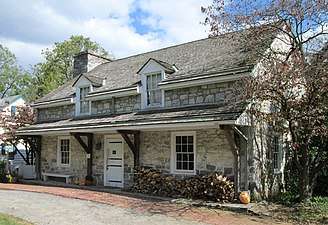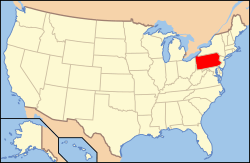Landis Valley Museum
The Landis Valley Village & Farm Museum is a 100-acre living history museum located on the site of a former rural crossroads village in Lancaster, Pennsylvania. Founded by brothers Henry K. Landis and George Landis in 1925 and incorporated in 1941, it is now operated by the Pennsylvania Historical and Museum Commission.[3] Its staff and volunteers collect, conserve, exhibit, and interpret Pennsylvania German material, culture, history and heritage from 1740 through 1940.
Landis Valley Village & Farm Museum | |
Landis House in September, 2012 | |
 Location in Pennsylvania  Location in United States | |
| Nearest city | Lancaster, Pennsylvania |
|---|---|
| Coordinates | 40°5′36″N 76°16′48″W |
| Area | 100 acres (40 ha) |
| Built | 1940 |
| NRHP reference No. | 99001578[1] |
| Significant dates | |
| Added to NRHP | January 3, 2000 |
| Designated PHMC | 1957[2] |
History
Planning for the Landis Valley Village & Farm Museum was undertaken during the early 1920s by brothers Henry K. Landis and George Landis, who had grown up in Lancaster, Pennsylvania during the 1870s and 1880s. With a shared interest in Pennsylvania history, and more specifically in Pennsylvania German history, they became active collectors of a range of historic artifacts, including antique furniture, arrowheads and other Native American relics, bullets, buttons, coins, Conestoga Wagons, dishes and glassware, farm equipment and tools, fossils, Fraktur, guns, pottery, and quilts. Following their retirement in 1924 from their respective careers as a mining and construction/sanitary engineer, the Landis brothers combined their respective collections at the Landis family's farm in Lancaster and, in 1925, officially opened many of their collected items to public viewing. As their holdings continued to grow and their educational attraction increased in popularity, they sought funding from the Carl Shurz Foundation to turn their buildings and collections into an official museum. The cultural attraction was then formally incorporated as the Landis Valley Museum in 1941, and a professional curator was hired to catalogue and display the brothers' collection. The foundation also facilitated the construction of a farm implement barn, gunsmith's shop, tavern, and wagon shed.[3][4]
In 1953, the aging Landis brothers deeded the museum and property to the Commonwealth of Pennsylvania, which transformed the operation into a living history museum by reconstructing historic structures on adjacent properties purchased by the state in order to develop educational programs that would show groups of teachers and school children, families, tour groups, and other visitors, firsthand, how Pennsylvania Germans lived, farmed and operated their manufacturing businesses during the 18th century. Guides who were specially trained in the performance of period tasks and making of period crafts, and then dressed in period costumes, were also then added as curators and staff continued to refine the museum's educational offerings.[3]
Heirloom Seed Project
During the mid-1980s, museum staff launched an initiative to preserve the purity of heirloom seeds, which were grown and harvested on Pennsylvania German homesteads and small farms prior to 1940. As of 2019, three production plots, six display gardens, and two hoop houses are being used to save and replant select seeds from year to year, ensuring that these strains of vegetables and other plants remain free from the impacts of modern hybridization. The museum also maintains records which document where each seed originated, and makes select varieties of seed available for sale each year to the general public at the museum's Herb & Garden Faire.[5][6]
Exhibits, educational programs and special events
This living history museum, which is part of the Pennsylvania State Museum system, celebrates the many inventions developed in Pennsylvania's Lancaster County region, birthplace of the Conestoga wagon and the Pennsylvania longrifle (also known as the Kentucky longrifle). Visitors are able to learn how Conestoga Wagons were made, including the critical process of making spoked wheels, and how 18th-century gunsmiths manufactured rifle barrels. In addition, guides dressed in period costumes explain the traditions and folklore of Pennsylvania Germans who resided in the area between 1740 and 1940 while specially trained artisans demonstrate the procedures for craftmaking and open-hearth cooking.
The features of the museum include:
- Visitor Center
- Landis House & Stable (life during the Victorian Era, between 1870 and 1890)
- Leatherworking Shop
- Pottery Shop
- Log Farm (life between 1760 and 1780)
- Yellow Barn
- Brick Farmstead (life between 1830 and 1850)
- Erisman House
- Blacksmith Shop
- Tavern
- Transportation Building
- Gun Exhibit
- Landis Valley House Hotel
- Conestoga Wagon Shed
- Maple Grove School
- Farm Implement Shed
- Steam Engine Building
- Textile Processes & Garden
- Country Store
- Isaac Landis House, Barn & Feed Mill
- Firehouse
- Tin Shop
- Landis Valley Museum Store
The museum also hosts a free annual bonfire with holiday caroling, as well as other special events throughout the year.[7]
Publications
- Crago, Carol, Chuck Greeholt, Mike Pengra, Pennsylvania Historical and Museum Commission, and Pennsylvania Commonwealth Media Services. Landis Valley: Pennsylvania German Heritage, 1750-1940. Harrisburg, Pennsylvania: Pennsylvania Commonwealth Media Services, 1999 and 2000. OCLC 48664960
- Heirloom Seed Reference Guide. Lancaster, Pennsylvania: Landis Valley Museum (Heirloom Seed Project), 1997. OCLC 37617829
- Herr, Patricia T., Stephen S. Miller, and Landis Valley Museum. Selected Quilts from the Landis Valley Museum. Lancaster, Pennsylvania: Landis Valley Associates, 2002. OCLC 261233360
- Landis, Henry K. and Elizabeth Johnson. Canoeing on the Juniata, 1888. Harrisburg, Pennsylvania: Pennsylvania Historical and Museum Commission and Landis Valley Associates, 1993. OCLC 29591875
- Landis, Henry Kinzer and George Diller Landis. Lancaster Rifle Accessories. Publication date circa 1944 (publisher's name and location not identified). OCLC 20751008
- Landis Valley Associates. The Landis Valley Cookbook: Pennsylvania German Foods and Traditions. Mechanicsburg, Pennsylvania: Stackpole Books, 2009. OCLC 951227767
- Landis Valley Museum. Fraktur, 1790-1850. Lancaster, Pennsylvania: Landis Valley Museum, 1977. OCLC 646678237
- Landis Valley Museum. The Landis Valley Museum, the Museum of Eastern Pennsylvania Folk Art. Lancaster, Pennsylvania: Publisher unknown, 1942. OCLC 78297319
- Pennsylvania Farm Museum of Landis Valley. Lancaster, Pennsylvania: Landis Valley Associates, 1963, 1968. OCLC 12001387
- Pennsylvania German Fraktur and color drawings: Exhibited at Pennsylvania Farm Museum of Landis Valley, Lancaster, Pennsylvania, May 19-June 30, 1969. Lancaster, Pennsylvania: Landis Valley Associates, 1969. OCLC 15510
- Pennsylvania Historical and Museum Commission Staff. Landis Valley Museum, Lancaster, PA: Rural Life. Harrisburg, Pennsylvania: Pennsylvania Historical and Museum Commission, 1988. OCLC 84977358
- Spiese, Monica D. and Landis Valley Museum. Plant Materials Used by Pennsylvania Germans in the 18th and 19th Centuries Relating to Textile Production and Dyeing: A research paper to support the design and implementation of a textile garden at the Landis Valley Museum. Lancaster, Pennsylvania: Landis Valley Museum, 1993. OCLC 33065607
Supporters
The Landis Valley Village & Farm Museum receives significant financial and volunteer assistance from the Landis Valley Associates, a 3,000-member non-profit community support organization. Members of the LVA receive complimentary museum admission and discounted admission to various special events, as well as discounts at the museum's store.[8]
Gallery
- Isaac Landis house, built 1875
 The Landis Valley Hotel, built in 1855-56
The Landis Valley Hotel, built in 1855-56- Yellow barn, built 1939
 The Tavern, a recreation of one from the early 1800s
The Tavern, a recreation of one from the early 1800s
References
- "National Register Information System". National Register of Historic Places. National Park Service. July 9, 2010.
- "Pennsylvania Farm Museum - PHMC Historical Markers". Historical Marker Database. Pennsylvania Historical & Museum Commission. Archived from the original on December 7, 2013. Retrieved December 23, 2013.
- Callanan, Laura Knowles (1995). "Landis Valley Museum: The Legacy of Two Brothers Lives On!". Trails of History. Pennsylvania Historical and Museum Commission. Archived from the original on December 13, 2013. Retrieved December 9, 2013.
- Kraft, John, et. al., ed. A Triad of Lancaster County History. Ephrata, Pennsylvania: Science Press, 1985.
- Day, Gloria. "Landis Valley Village & Farm Museum preserves Pennsylvania German culture through its Heirloom Seed Project." Reading, Pennsylvania: Reading Eagle, May 8, 2019.
- "The Heirloom Seed Project." Lancaster, Pennsylvania: Landis Valley Farm Museum, retrieved online September 6, 2019.
- Landis Valley Farm Museum hosts holiday events December 13-15. Lancaster, Pennsylvania: LNP Media Group, December 10, 2013.
- "Landis Valley Museum" (profile). Lancaster, Pennsylvania: Lancaster County Museum Council, retrieved online September 6, 2019.
External links
| Wikimedia Commons has media related to Landis Valley Museum. |
- Landis Valley Farm Museum (official website)
- Manuscript Group 447: Landis Valley Farm Museum Collection (ca. 1749-1982). Harrisburg, Pennsylvania: Pennsylvania State Archives, retrieved online September 6, 2019.


